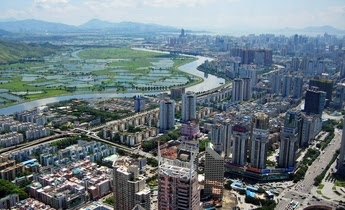Toward a Unified Theory of Cities
 We are in the midst of a tug-of-war between different kinds
of communities – urban, suburban, rural – that has generational, racial, and
political dynamics and that is at times contentious in nature. I hope with today’s ramblings not to add heat
but perhaps to shed light.
We are in the midst of a tug-of-war between different kinds
of communities – urban, suburban, rural – that has generational, racial, and
political dynamics and that is at times contentious in nature. I hope with today’s ramblings not to add heat
but perhaps to shed light.
First let me say that all kinds of communities are important
and necessary to a vibrant nation, society, and economy. And that is because different people have
different preferences. Sometimes we
city-lovers, perhaps not realizing just how big a chip we have on our shoulders
from all the city-bashing we’ve endured, can act as if people’s aversion to
cities is due to ignorance or worse. “If
you’d just keep an open mind and try us out, you’d realize how awesome we are”
is the sentiment. And there’s truth in
that sentiment. But there’s also truth
in the sentiment that different people have different preferences, and that
some people prefer not to live in cities, and that preference has nothing to do
with lack of exposure or close-mindedness.
It has to do with the fact that where you live is a bundle of goods, and
that bundle looks different in different places, in ways that cause me to
choose one place and you (with a different set of criteria for what is
important and what is tolerable) to choose another place.
Second, let me say that because all kinds of communities are
important, it is important to be fair and balanced in making sure that all
places have an opportunity to compete for resources – for residents, businesses,
investments, and services – and that all places feel a sense of connection to
other places. We shouldn’t give up on
certain communities, because we need them.
And we shouldn’t put certain communities against other communities,
because there’s a lot of ways our respective wellbeing is connected such that
somebody’s gain can also be somebody else’s gain. Easier said than done in a time of scarce
resources and rampant inequality, but no less true and therefore no less
necessary to believe and implement.
Third, and at the risk of sounding like I am contradicting
everything I have just now said, there is something to be said about the
importance of cities and of investing in cities. Since as far as we can look back, the
concentration of people and activity that cities have represented has unleashed
the best of human progress. To be sure,
that progress is uneven and not always equitably shared. But density gives us the best chance for both
innovation and inclusion rather than stagnation and segregation. We are most innovative, not in a vacuum, nor
when we are others like us, but when we are near others different from us and
given many opportunities to intersect and iterate. And we are most inclusive when we are given
opportunity to, by choice and by accident, rub elbows with people different
from us, from which we can realize how valuable and pleasurable it is to be
exposed to new ideas (and foods and cultural practices and life
perspectives).
The nitty gritty of pulling this off in cities around the
world is hard work involving billions of details. But a few big-picture themes seem to warrant
focus:
1. Mind the places and programming that allow different people
to be together and exchange ideas. Cities
are full of people brimming with ingenuity; will we make it easy for them to
find and connect with each other? Or
will we, through omission or commission, encourage more isolation and
segregation?
2. Don’t make it hard to form new businesses, start new initiatives,
or build new housing. When physical and
emotional space seems crowded, it can be tempting to be stingy towards the
new. But the urban form thrives
precisely because it is dense and can get denser, so we need to be OK letting
it do that. Let a thousand flowers
bloom! Some may not survive, and that’s
OK, but the rest will attract and engage a wider swath of people and expand the
circle of participants and contributors further.
3. Invest in infrastructure of all kinds so that people can physically
circulate freely, easily, and pleasurably.
The killer app of cities from Chicago to Shanghai. Large concentrations of people and activity
in one place can only happen when we invest in transportation forms that can
scale accordingly.
4. Invest in education of all kinds so that people can professionally
circulate freely, easily, and pleasurably.
Just as transportation infrastructure allows people to physically move
around, education allows people to move freely professionally and vocationally,
yielding huge returns to them and to society as a whole as they weave in and
out of ideas and industries.
That’s my unified theory of cities. What do you think?

Comments